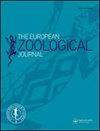南波罗的海沿岸林莺秋季迁徙时间的长期变化是对春夏秋气温的反应
IF 1.4
4区 生物学
Q2 ZOOLOGY
引用次数: 1
摘要
摘要近几十年来,为了应对气候变化导致的气温上升,许多欧洲候鸟早就离开了繁殖地。我们利用1967年至2018年波兰波罗的海沿岸Bukowo Kopań振铃站的数据,研究了未成熟花园莺秋季迁徙时间的长期变化。我们计算了迁徙的年度异常(AA),以及每个站点捕获10%、50%和90%候鸟的日期。我们在多元线性回归模型中,将AA和每个站点的这些百分位数的日期与一年和两个月的春季、夏季和秋季温度作为解释变量进行了建模。未成熟花园莺的总传代(AA)提前了7天,第50和90个传代百分位数的日期提前了6-11天。总的来说,50%的通过日期发生在芬兰夏季气温升高的较晚时间。我们建议,在温暖的夏天,在这些繁殖地和最初的中途停留地有有利的觅食条件,因为这些缺乏经验的鸟类在向南迁徙之前利用这些条件积累了燃料,所以推迟了迁徙。整个迁徙以及10%、50%和90%的秋季迁徙日期发生得越早,意大利春季迁徙路线上的春季温度越高,瑞典南部和挪威繁殖地的夏季平均温度也越高。我们认为这是一种跨代遗传效应,因为温暖的春天鼓励返回的成虫提前到达和筑巢,从而提前孵化和孵化幼体,而幼体在温暖的夏天也生长得更快。这些影响使幼崽在温暖的繁殖季节后能够在秋季更早地迁徙。因此,欧洲春季和夏季气温的长期上升有助于解释花园莺迁徙时间的变化。本文章由计算机程序翻译,如有差异,请以英文原文为准。
Long-term changes in autumn migration timing of Garden Warblers Sylvia borin at the southern Baltic coast in response to spring, summer and autumn temperatures
Abstract Many migrant European birds have been departing their breeding grounds earlier in recent decades in response to rising temperatures from climate change. We examined long-term changes in the autumn migration timing of immature Garden Warblers using data from ringing station Bukowo-Kopań on the Polish Baltic coast in 1967–2018. We calculated an Annual Anomaly (AA) of migration and the dates when 10%, 50% and 90% of migrating birds were caught at each station. We modelled AA and the dates of these percentiles of passage for each station against the year and bi-monthly spring, summer and autumn temperatures as explanatory variables in multiple linear regression models. The overall passage (AA) of immature Garden Warblers advanced by 7 days and the dates of the 50th and 90th passage percentiles advanced by 6–11 days. Overall passage, and dates for 50% of passage occurred later the higher summer temperatures rose in Finland. We suggest favourable foraging conditions in warm summers at these breeding grounds and at first stopover sites delayed the passage because these inexperienced birds took advantage of the conditions to accumulate fuel before migrating south. The overall passage, and the dates of 10%, 50% and 90% of autumn passage occurred the earlier the higher were spring temperatures on spring migration route in Italy, and the higher were mean summer temperatures at breeding grounds in southern Sweden and Norway. We suggest a trans-generation carry-over effect, as warm springs encourage early arrival and nesting of returning adults, thus earlier broods and hatching of juveniles, which also grow faster in warm summers. These effects enable immatures to migrate earlier in autumn after a warm breeding season. The long-term increase in Europe’s spring and summer temperatures thus help explain the shift in Garden Warblers’ migration timing.
求助全文
通过发布文献求助,成功后即可免费获取论文全文。
去求助
来源期刊

European Zoological Journal
Agricultural and Biological Sciences-Animal Science and Zoology
CiteScore
3.10
自引率
5.60%
发文量
80
审稿时长
30 weeks
期刊介绍:
The European Zoological Journal (previously Italian Journal of Zoology) is an open access journal devoted to the study of all aspects of basic, comparative and applied protozoan and animal biology at molecular, cellular, tissue, organ, organismal, population, and community-ecosystem level. Papers covering multiple levels of organization and integrative approaches to study animal form, function, development, ecology, evolution and systematics are welcome. First established in 1930 under the name of Il Bollettino di Zoologia, the journal now has an international focus, reflected through its global editorial board, and wide author and readership.
 求助内容:
求助内容: 应助结果提醒方式:
应助结果提醒方式:


